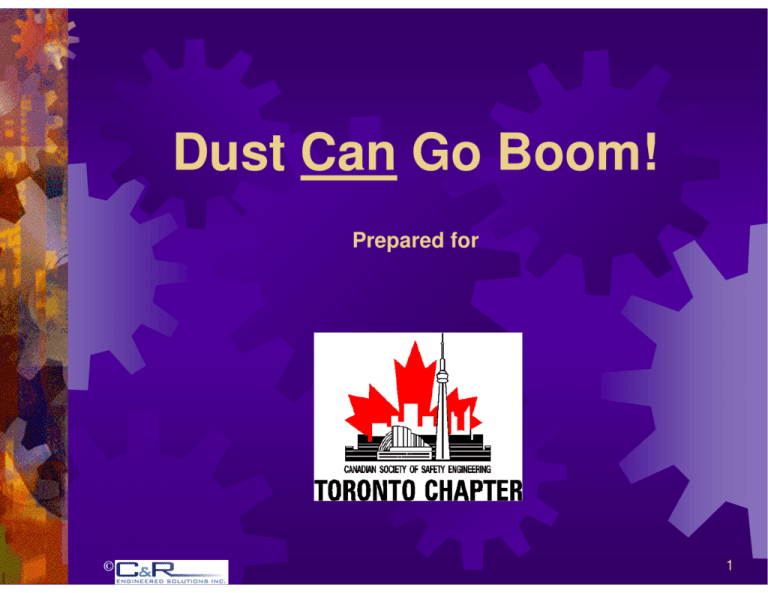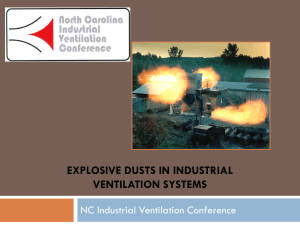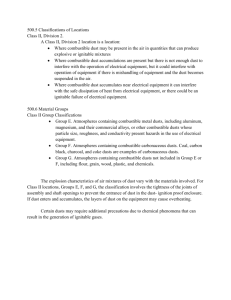Dust Can Go Boom!
advertisement

Dust Can Go Boom! Prepared for © 1 Overview Applicable Regulations. What causes Dust Explosions? What can you do to prevent Dust Explosions? Other engineering considerations for Explosive Atmospheres. © 2 Applicable Regulations O. Reg. 851 Section 63 - Process involves risk of ignition or explosion of gas, vapour, dust or fume….(PSR required) O. Reg. 851 Section 64 – Hazard of dust explosion created by foreign particles… separator required….. O. Reg. 851 Section 65 – Use of dust collector for aluminum, magnesium or other fine dust of an ignitable nature involves risk of ignition or explosion….(PSR required) O. Reg. 851 Section 66 – Compressed air shall not be used for blowing dust….in such a manner to endanger a worker. © 3 Enforcement Northern Sawmills Inc. fined $80,000 after workers suffered minor burns after a baghouse fire and dust explosion. 1. Failing to ensure there was a spark detection or suppression system in the dust collector system between planer and collector. (25(2)(h)) 2. Failing to provide information, instruction and supervision in dealing with a possible explosion in the baghouse. (25(2)(a)) © 4 More Regulations Ontario Electrical Safety Code (OESC) Section 18 – Hazardous locations classification of electrical equipment used in: Class II locations – combustible dusts Class III locations – ignitable fibres or combustible flyings This prescribes equipment and installation methods. ESA will not approve power connection to a hazardous area without an engineer’s sealed drawing showing extent of the area and the classification. © 5 More Regulations Ontario Fire Code Part 5 – Hazardous Materials, Processes and Operations. Section 5.10 - Combustible Dust Producing Processes. Rules for dust collectors….. Section 5.12 – Spray Application using Flammable or Combustible Materials – this can include combustible dusts e.g powder coating. Rules for concentration, ventilation, equipment, ductwork….. © 6 How does it “Go Boom” Statistics for Ontario are scarce but quite well documented in the USA. There have been more than 120 workers killed, more than 700 severely injured, in more than 300 documented dust explosions in the last 25 years. Typically multiple deaths. The following CSB video will talk about Dust Explosions and how they occur using real life examples: Combustible Dust: An Insidious Hazard © 7 Common Issues Lack of understanding of the hazard by users and regulators. MSDS not accurate (sorbitol example). Use of compressed air and other dust “movers”. Poor housekeeping. Improper equipment and building design. Dust not analyzed. © 8 Preventive Measures Risk assessments. Understand the hazards. Training – at all levels. PSR(s) required? Are existing safeguards adequate for today’s operations and do they meet current Fire Code and Electrical Safety Code requirements? Do you have any hazardous areas that need classification due to combustible dusts? Do you have specific safe work instructions for these areas – e.g. hot work permits? Perform your own dust test. 24 hour buildup on typical horizontal surface less than 1/8” but surface colour not discernible = Class II; colour visible = unclassified. More than 1/32” of combustible dust over 5% of room’s surface area can present significant explosion hazard. © 9 Applicable Codes & Standards OHSA and O. Reg. 851 as amended Ontario Electrical Safety Code Ontario Fire Code WHMIS Health Canada Advertisement WHMIS Announcement NFPA Standards: 61, 68, 69, 77, 484, 497, 499, 654, 655, 664 © 10 Dust Hazard Rating Published by New Zealand Department of Labour 1985 – see attached. OSHA Poster - Combustible Dust Poster Combustible metals can include: © Aluminum Magnesium Niobium Tantalum Titanium Zirconium Dust analysis will become very important for anyone involved with nano particle manufacturing or use. 11 Engineering Considerations for Explosive Atmospheres Is a Pre-Start Health and Safety Review (PSR) required under Section 7? If the PSR was done, have you followed up on the recommendations? e.g. battery charging areas. Has the hazardous area been assessed by an engineer for OESC classification? Is the electrical equipment approved for the classification? Are your forklifts rated for the classified area (505)? Are your flammable storage cabinets grounded? Do you have a good quality grounding and bonding installation where required? Is the grounding and bonding system checked and verified on a regular basis? Do you use approved equipment for ventilation, dust collection and housekeeping? © 12 Reference Material Links OSHA – www.osha.gov/dsg/combustibledust NFPA - www.nfpa.org/ CSB - www.csb.gov/ WHMIS – www.whmis.gc.ca ESA - www.esainspection.net/ CSA - www.csa.ca/cm/ca/en/home Grounding – www.newson-gale.com “Safe” Vacuums - www.tiger-vac.com/productline/category-2.html Dust Analysis - www.emsl.com/ MOL Dust Collector Alert – www.labour.gov.on.ca/english/hs/pubs/alerts/i15. php MOL Woodworking operations Data Sheet 4-12 © 13 © 14 Questions? Don’t hesitate to contact us! C&R Engineered Solutions 8193 Esquesing Line Milton ON L9T 2X9 905-864-0400 Laurence Polley, B.Sc., MBA, P.Eng., CHSC lpolley@engineeredsolutions.ca Cell: 416-209-7282 John Mulhall, Master Electrician jmulhall@engineeredsolutions.ca Cell: 416-801-2981 © 15





